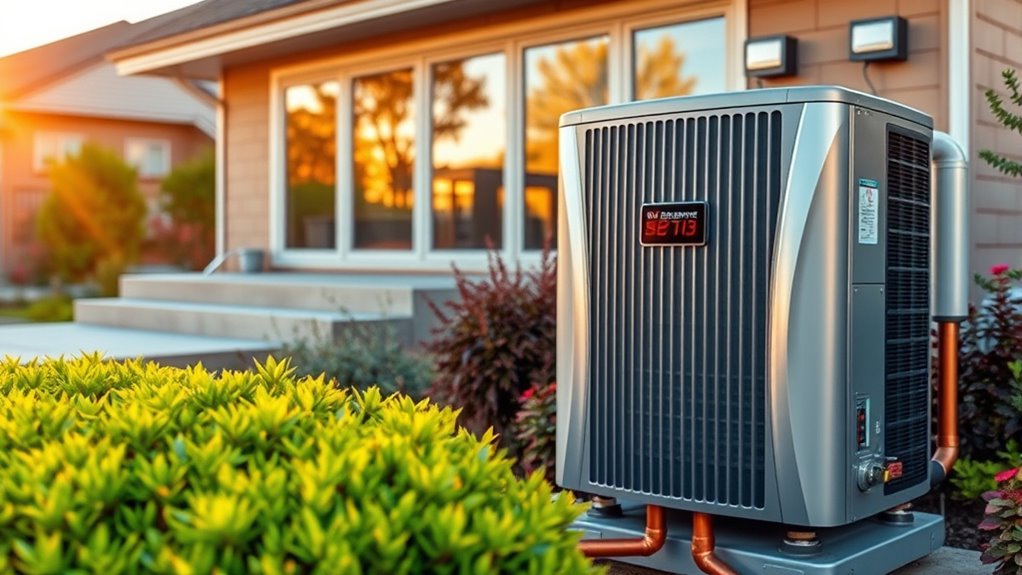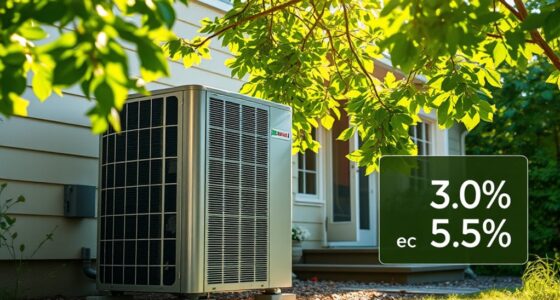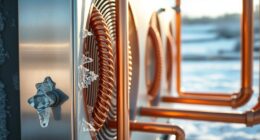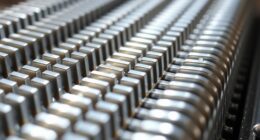To calculate your long-term savings with a heat pump, start by estimating your energy consumption based on efficiency ratings, climate, and household habits. Subtract potential incentives and rebates to find your initial cost. Then, compare your local utility rates and consider seasonal temperature effects on performance. Regular maintenance also impacts savings over time. If you want a clear picture of your investment’s benefits, follow along as this guide breaks down each step.
Key Takeaways
- Estimate annual energy savings based on system efficiency, climate conditions, and household energy consumption patterns.
- Include installation costs, incentives, rebates, and tax credits to determine net upfront investment.
- Calculate payback period by dividing net initial costs by annual savings.
- Adjust energy use estimates for seasonal temperature variations and rate structures like tiered or time-of-use rates.
- Incorporate long-term factors such as maintenance costs and property value benefits for comprehensive savings analysis.
Understanding the Components of Long-Term Savings
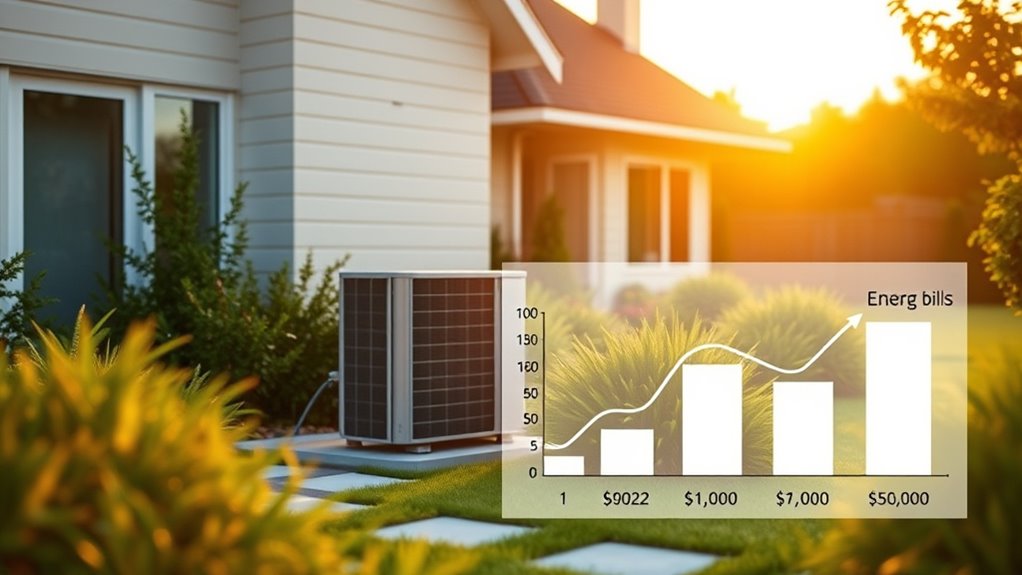
Understanding the components of long-term savings helps you see how installing a heat pump can pay off over time. Your energy consumption directly affects utility bills, so higher efficiency means lower costs. Heat pumps with good SEER and AFUE ratings use less energy to heat and cool your home, increasing your savings. Keep in mind, installation costs and available rebates can influence your payback period, making the investment more affordable upfront. The rate structure of your utility bills, such as tiered or time-of-use rates, also impacts your overall savings by affecting how much you pay for energy during different times. External factors like climate, insulation, and your habits further shape how much you save long-term, emphasizing the importance of a proper system sizing and comprehensive approach. Additionally, choosing a high-efficiency system can significantly boost your savings over the lifespan of your heat pump. Furthermore, understanding energy efficiency ratings can guide you toward the most cost-effective options. Incorporating smart controls can further optimize energy use and maximize your long-term savings.
Analyzing Installation Costs and Incentives
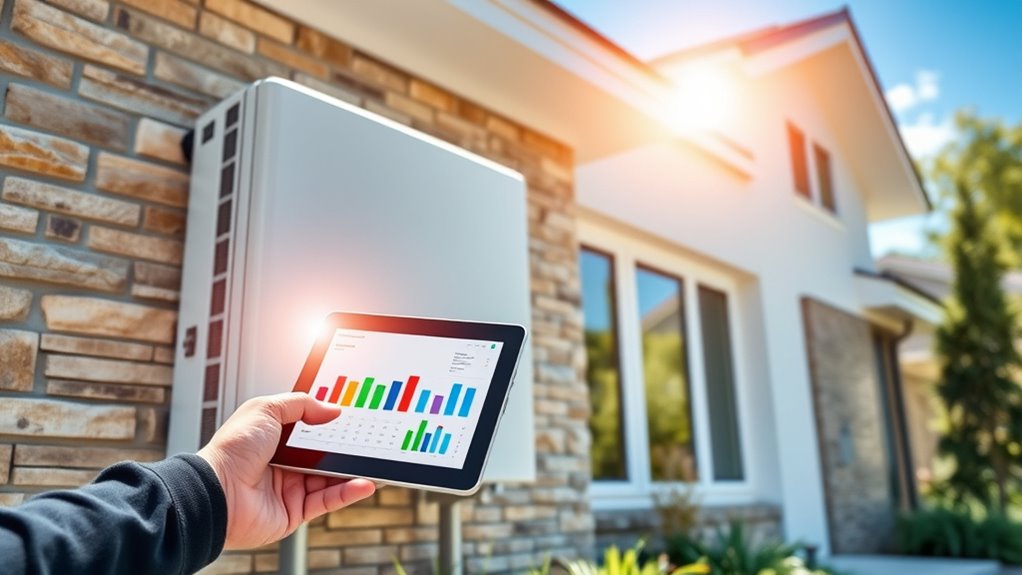
Understanding your installation costs is key to evaluating long-term savings, especially since heat pumps often cost less than traditional systems when incentives are considered. You should explore available rebate programs and tax credits that can substantially lower your upfront expenses. These incentives directly impact your payback period, making a heat pump a more attractive financial choice. Additionally, be aware of website privacy policies and how cookies may track your interactions, which can influence targeted advertising and data collection during your research. Being informed about cookie management options can help protect your privacy while you compare different rebate programs and incentives. Recognizing the importance of financial incentives can further motivate you to pursue energy-efficient upgrades that enhance your savings. Moreover, understanding the installation process can help you anticipate potential costs and minimize unexpected expenses. Incorporating energy efficiency considerations when selecting a heat pump can also maximize your long-term savings by reducing operational costs.
Installation Expenses Overview
Installing a heat pump involves a range of costs that can substantially impact your decision-making process. Installation costs vary widely, typically between $3,000 and over $10,000, depending on the system type and home complexity. Air source heat pumps usually have lower upfront expenses, often around $3,000 to $7,000, making them more accessible. Ground source (geothermal) systems, however, tend to be more expensive, often exceeding $10,000, due to underground loop installation. Incentives, rebates, and tax credits from federal, state, and local programs can considerably reduce these upfront expenses, helping make installation more affordable. Proper assessment and professional installation are essential, as improper setup can lower system efficiency and diminish long-term savings.
Available Incentive Programs
Incentive programs play a substantial role in lowering the overall costs of installing a heat pump. These incentives, including rebates, tax credits, and utility discounts, can reduce installation costs by 20-50%. For example, the Inflation Reduction Act offers tax credits of up to $8,000 for qualifying systems, drastically cutting expenses. Many utilities also provide rebates ranging from $500 to $2,500, depending on your region and the specific program requirements. Keep in mind that some incentives require professional installation and adherence to efficiency standards, which can affect the total rebate amount. By combining multiple incentives and rebates, you can markedly improve your return on investment, making heat pump installation more affordable and accessible. Additionally, understanding efficient general ledger coding can help you better track and manage these incentives and rebates for financial planning purposes. Incorporating sound design principles into your financial tracking can further streamline managing these complex incentives and ensure you maximize your savings. Staying informed about energy efficiency standards can also help you qualify for additional incentives and optimize your system’s performance. Being aware of long-term maintenance costs associated with different heating systems can further improve your financial planning and overall savings.
Impact on Payback Period
Have you considered how installation costs and available incentives influence the time it takes to recoup your investment in a heat pump? Your payback period depends on the initial costs and energy savings your system provides. High-efficiency heat pumps typically cost between $4,500 and $9,000 upfront, but rebates and incentives, like those from the Inflation Reduction Act, can cover up to 30% of these costs, reducing your initial investment. With annual energy savings of around $1,000 to $1,200, your payback period can range from 4 to 9 years. In regions with higher energy prices or larger homes, savings increase, shortening the payback time to less than 5 years. Evaluating these factors helps you determine the most cost-effective timeline for your investment. Additionally, considering the benefits of cold-pressed vegetable juice can improve your overall health and energy levels, supporting a sustainable lifestyle alongside your energy-saving efforts. Incorporating eco-friendly practices such as using renewable resources can further enhance the sustainability of your home heating solutions. Moreover, understanding the efficiency of modern HVAC systems can help maximize your energy savings and shorten your payback period over time. Staying informed about technological advancements in heat pump design can also contribute to long-term savings and system performance. Regular maintenance and proper system sizing are essential for maintaining optimal heat pump performance and ensuring consistent energy savings.
Estimating Energy Consumption With a Heat Pump
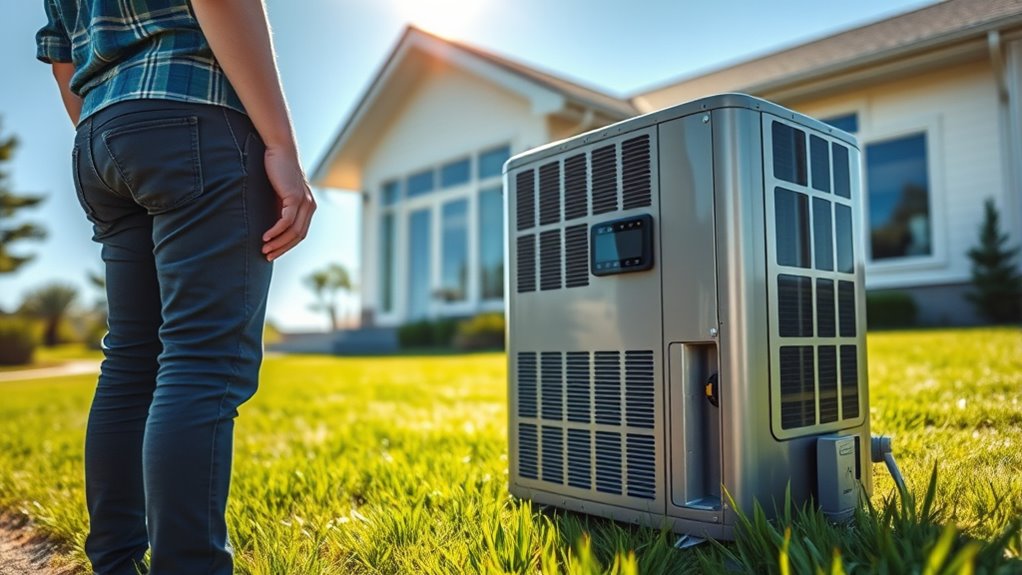
To estimate your heat pump’s energy use, you need to take into account seasonal variations and temperature changes. By calculating the expected energy consumption during different months, you can better predict your long-term savings. Adjusting for outdoor temperature fluctuations ensures your estimates remain accurate throughout the year. Incorporating energy efficiency improvements from proper tuning can further optimize your heat pump’s performance and savings. Additionally, understanding vetted Halloween product reviews can help you select the most efficient and cost-effective equipment for your needs. Considering market conditions related to energy prices can also impact your overall savings calculations over time. Moreover, factoring in the climate’s impact on energy use helps tailor your estimates to your specific geographic location, leading to more precise long-term savings projections. Evaluating technology advancements can also lead to more accurate predictions of future efficiency gains and savings potential.
Calculating Seasonal Energy Use
Estimating the seasonal energy use of a heat pump requires understanding how outdoor temperatures impact its efficiency and electricity consumption. As temperatures fall, the efficiency rating decreases, causing higher energy consumption during colder months. To accurately estimate seasonal energy use, you should consider heating degree days (HDD), which measure how much and for how long temperatures stay below comfort levels. By combining HDD data with your heat pump’s efficiency rating—such as SEER and HSPF—you can determine how much energy your system will consume over the season. Typically, you multiply your home’s heating load by the season’s heating hours and then divide by the efficiency rating. This approach helps you forecast seasonal energy consumption and plan for long-term savings effectively. Additionally, understanding the raw nutritional value of components like nuts and seeds can inform energy-efficient choices for meal planning and overall health. Incorporating cost and budgeting considerations can also help you select a heat pump that balances upfront investment with ongoing savings, especially when considering the long-term operational costs associated with different models. Recognizing the impact of climate on heating demands allows for more accurate energy use estimates and better system sizing. Moreover, considering energy efficiency standards can guide you in choosing models that perform optimally under varying climate conditions.
Adjusting for Temperature Variations
Since outdoor temperatures directly influence a heat pump’s efficiency, adjusting your energy consumption estimates accordingly is vital. As temperatures drop, your heat pump’s efficiency decreases, leading to increased energy use. Modern cold climate heat pumps are designed to perform efficiently at outdoor temperatures as low as -15°F to -20°F, reducing additional energy consumption during colder months. To accurately estimate energy use, consider how temperature variations impact the heat pump’s coefficient of performance (COP). The total heating load fluctuates with outdoor temperatures, so your calculations should account for these variations. By combining outdoor temperature data, performance curves, and household heating needs, you can better project long-term savings and ensure your estimates reflect real-world conditions.
Comparing Local Electricity Rates and Tariff Structures
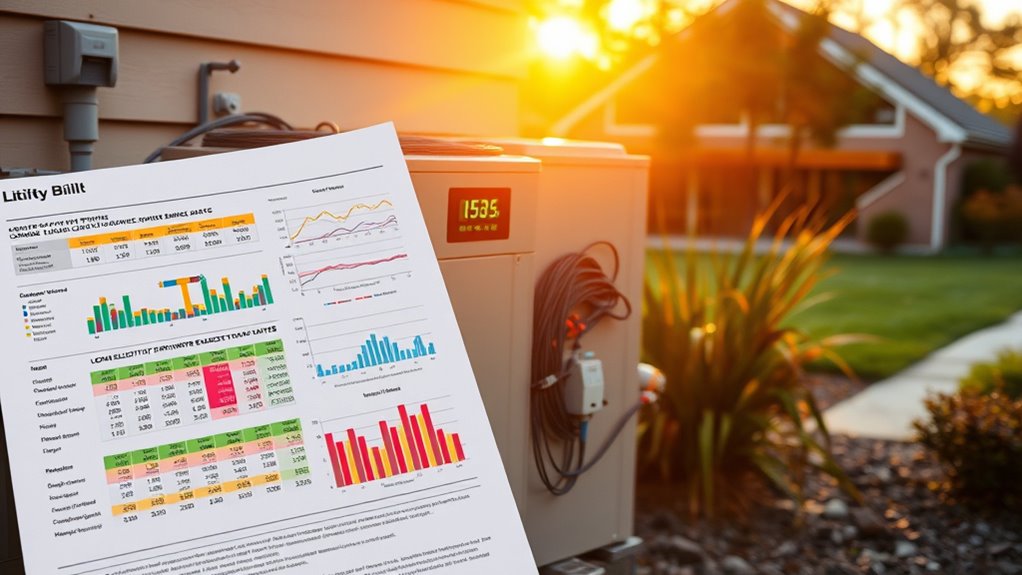
Understanding your local electricity rates and tariff structures is essential for accurately evaluating the long-term savings of installing a heat pump. Utility rates vary widely, with some areas using tiered pricing that increases costs as your energy consumption rises, potentially reducing savings. Time-of-use tariff structures charge higher prices during peak hours, which can influence when you operate your heat pump to maximize savings. If your electricity rates are high—say, $0.20 per kWh instead of $0.10—you’ll see less financial benefit despite the efficiency of your system. Tiered rates may also cause your bills to spike as heat pump use pushes you into higher-cost tiers. Comparing local utility rates and understanding whether your utility uses flat, tiered, or time-of-use pricing helps you estimate your long-term energy costs accurately.
Impact of Climate and Outdoor Temperatures on Efficiency
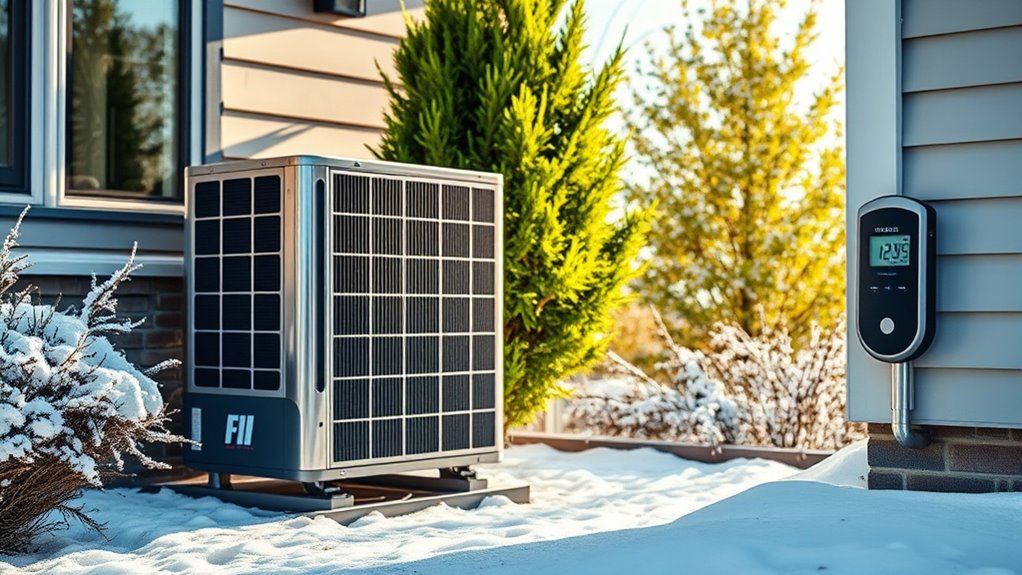
Outdoor temperatures considerably influence the efficiency of your heat pump, especially during cold weather. As outdoor temperatures drop, the efficiency of your heat pump decreases because it has to work harder to extract heat from the environment. In colder climates, outdoor temperatures below freezing can limit performance, leading to increased reliance on resistive heating and higher energy use. However, modern cold climate heat pumps are designed to operate effectively even at outdoor temperatures as low as -20°F, maintaining high efficiency and capacity. The AHRI certification data shows how BTU output varies with temperature, highlighting capacity changes as temperatures fall. Well-designed models minimize efficiency losses, ensuring your heat pump remains cost-effective regardless of climate.
How Rate Structures Influence Bill Savings
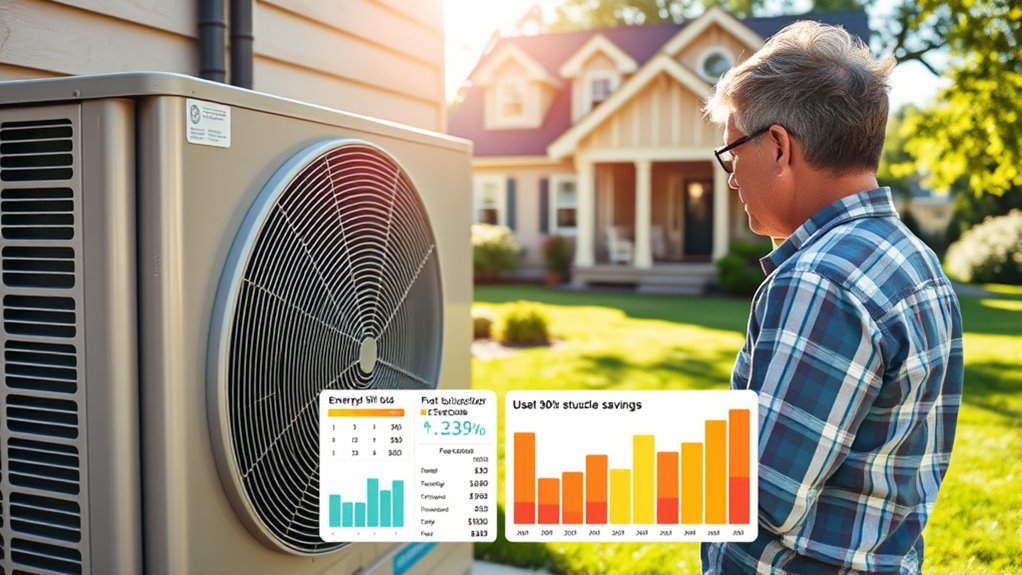
Your bill savings from a heat pump can be affected by how your utility prices electricity. Tiered and time-of-use rates can push your costs higher during peak periods, reducing your overall savings. Understanding these rate structures helps you better estimate the true financial benefits of installing a heat pump.
Rate Complexity Impacts Savings
Rate structures like tiered and time-of-use pricing can considerably affect the actual savings you see from installing a heat pump. Tiered rates push your household consumption into higher-cost brackets, which reduces overall savings because your energy costs increase as usage rises. Time-of-use rate structures cause bill fluctuations depending on the hour, making straightforward savings calculations more difficult. When your energy use shifts into higher-rate tiers, the economic benefits of switching to a heat pump diminish. Relying solely on average electricity rates often overstates savings, since marginal costs during peak periods are higher. These complex rate designs emphasize the importance of detailed rate analysis to accurately project long-term savings, as they directly influence how energy costs are calculated and how much you can truly save with a heat pump.
Tiered and Time Rates
Understanding how different rate structures work is key to accurately estimating your savings with a heat pump. Tiered rates increase your electricity cost as your household usage exceeds certain thresholds, which can limit potential savings. If your energy consumption pushes you into higher-cost tiers, the bill reductions from switching to a heat pump may be offset. Time-of-use rates charge more during peak hours, meaning heating during expensive periods reduces your overall savings. Combining tiered and time-of-use rates further complicates savings estimates, as both factors influence the marginal electricity cost at different times and usage levels. To get an accurate picture, you need to understand how these complex rate structures affect your electricity cost and how they impact the long-term financial benefits of installing a heat pump.
Calculating Payback Periods and Return on Investment
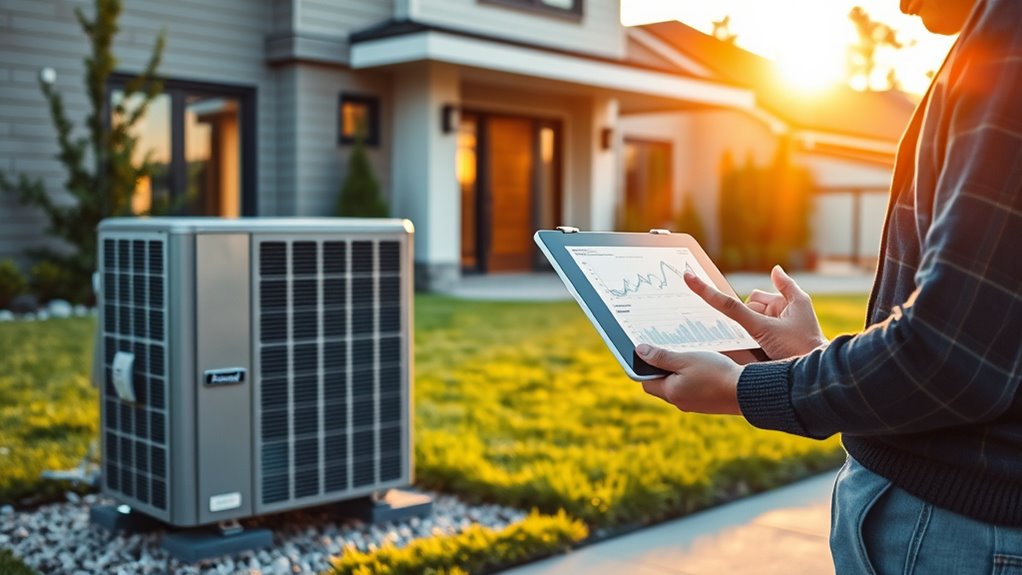
Calculating the payback period and return on investment (ROI) for a heat pump helps you determine how quickly the initial costs will be offset by energy savings. To find the payback, divide the initial cost by your annual energy savings. For example, a $15,000 system saving $1,000 a year results in a 15-year payback. Upgrading to a higher efficiency heat pump with better SEER and AFUE ratings can reduce operating costs and shorten this period. Additionally, incentives, rebates, and tax credits can lower upfront costs, boosting ROI and speeding up the payback. Keep in mind, local energy prices influence savings, with higher rates leading to faster recoupment. Overall, a thorough ROI analysis shows when your investment will break even and start saving you money long-term.
Incorporating Maintenance and Operational Savings
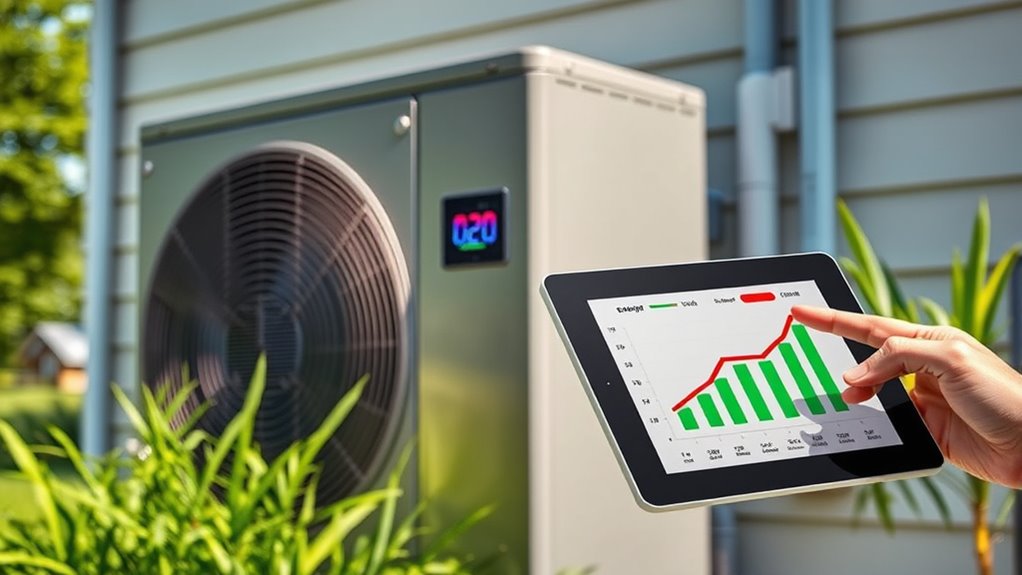
Incorporating maintenance and operational savings can substantially boost the long-term financial benefits of installing a heat pump. Since heat pumps require less maintenance than traditional systems, you’ll see up to 30% lower annual service costs. Regular filter changes and minor inspections can extend your system’s lifespan, reducing costly repairs later. Additionally, modern heat pumps maintain high efficiency even in cold weather, lowering operational costs. The fewer moving parts and diminished need for fuel deliveries mean ongoing expenses stay minimal. Over time, these combined savings from reduced maintenance and operational costs can total thousands of dollars, greatly improving your long-term return on investment. By factoring in these savings, you’ll have a clearer picture of the true financial advantage of choosing a heat pump.
Evaluating Additional Benefits: Property Value and Emissions

Installing a heat pump can considerably boost your property’s value by making your home more energy-efficient and attractive to environmentally-conscious buyers. With improved energy efficiency, your home may see up to a 3% increase in property value, especially as energy performance ratings become more influential in property valuations. Moving to electric heating reduces emissions, helping lower your community’s carbon footprint and enhancing local air quality. Homes with heat pumps often qualify for incentives and rebates, further elevating their market appeal and resale value. Additionally, upgrading to a heat pump can improve indoor air quality by reducing combustion byproducts and providing better ventilation. Overall, these benefits make your property more desirable while contributing positively to the environment.
Using Tools and Models to Refine Your Savings Estimate

To obtain a more accurate estimate of your long-term savings from installing a heat pump, leveraging specialized tools and models is essential. These tools factor in complex elements like energy efficiency, utility rates, and seasonal variations, giving you a clearer picture of potential cost savings.
- Use energy efficiency analysis software to input your local utility rates, outdoor temperature profiles, and household energy patterns, simulating real-world energy consumption.
- Incorporate models that account for seasonal variations, tiered billing, and time-of-use rates, refining your savings projections beyond basic averages.
- Compare multiple scenarios—such as different system efficiencies or fuel prices—to identify the most cost-effective options and better understand your long-term financial benefits.
Frequently Asked Questions
How Much Can I Save by Installing a Heat Pump?
You wonder how much you’ll save by installing a heat pump. Depending on your current system and energy use, you could save around $370 annually, or nearly $1,000 if switching from fuel oil or propane. Upgrading to a high-efficiency model or replacing an old furnace can considerably cut your heating costs. Over time, these savings add up, making the investment worthwhile and helping you recoup costs within 10-15 years.
What Are the Savings With a Heat Pump?
You might think your savings are small, but switching to a heat pump can transform your energy bills completely. On average, you’ll save around $370 annually, and for homes using fuel oil or propane, that jumps to over $1,000! With higher efficiency and better insulation, your savings grow even more. Over time, these savings can cover the initial cost, making your investment pay off in just a decade or so.
What Is the ROI on a Heat Pump?
You’re wondering about the ROI on a heat pump. Typically, you’ll see a payback period of around 10-15 years, with annual savings of about $1,000. If you upgrade from less efficient systems and take advantage of rebates and incentives, your ROI improves. In colder climates or high-energy bills, the savings increase, making the investment even more worthwhile over the long term.
How Long Until a Heat Pump Pays for Itself?
You’re wondering how long it’ll take for a heat pump to pay for itself. Typically, it takes between 8 to 15 years, but this depends on your initial costs, energy prices, and climate. If you upgrade from an older system or live in an area with high energy rates, it might be closer to 7-10 years. Incentives and rebates can also help shorten this timeframe, making the investment more attractive.
Conclusion
Calculating your long-term savings with a heat pump is like planting a tree that grows bigger and stronger over time. By understanding costs, energy use, climate impacts, and incentives, you can see how this investment pays off. Use tools and models to fine-tune your estimate, and remember, the payoff is worth the wait—like watching a small sapling turn into a majestic tree, your savings will flourish for years to come.
